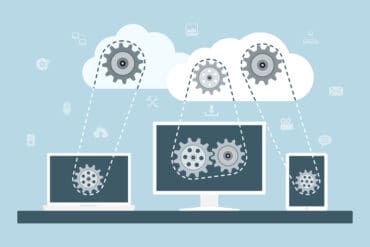
We discuss integration challenges and how the use of AI, no code and low code techniques, and automation can help companies overcome them.
Businesses today frequently need to build and modernize applications to create new, engaging customer experiences and deliver new products and services to drive top-line growth. These efforts require moving, sharing, and gaining visibility into information that is often siloed in legacy systems, cloud applications, and more. As such, a secure and scalable integration strategy is critical to successful digital transformation.
![Featured Resource: Embracing a Transformative Approach to Business-led Integration [Read Now]](https://no-cache.hubspot.com/cta/default/8019034/9919b744-7cf0-4636-8c23-71fd85f681a4.png)
Unfortunately, traditional approaches to integration can often be a complex undertaking. And most companies simply do not have the technical resources to throw at the problem. RTInsights recently sat down with Eileen Lowry, VP of Product Management of Integration Software, at IBM to discuss these challenges and how the use of AI, no code and low code techniques, and automation can help companies overcome their integration challenges. Here is a summary of our conversation.
See also: Embracing a Transformative Approach to Business-led Integration
RTInsights: What are some of the major integration challenges companies face today?

Lowry: There are three in my mind. The first is that companies are trying to transform existing applications. They’ve had mission-critical systems and applications that they’ve been using for some time, and they need to transform and modernize those applications for use in the modern-day and to future-proof their business.
Look at the modern approach to payments where I might pay online, or I might pay a friend through an app on my phone. The challenge is that you have information in systems that are not easily accessible, and you must be conscious of how much of that information gets exposed out into the broader world.
The second challenge is on driving new strategies and figuring out which technologies to use. How do I connect to information that I need from the mission-critical systems in new applications? Which tool should I be using to integrate, and how should I get that information from point A to point B in order to bring everything together?
The third challenge is the skills and the labor shortage that exists because you have fewer specialists that understand your mission-critical systems. To combat this, businesses need to provide more low code and no code tools that can be used by business analysts, less technical integration specialists, and citizen integrators. Such integration tools are important today because they speed up projects and let businesses do more with less.
See Also: Center for Automated Integration
RTInsights: There are different ways to address these challenges. Maybe we could discuss them with respect to three focus areas. Let’s start with creating and managing APIs to enable digital business through new channels.
Lowry: Whether you are trying to transform mission-critical systems or build new applications, the focus is the same: how can you securely expose information? You can do that by creating, publishing, sharing, and socializing APIs to be used for new applications that you’re building for those new digital channels. But you must do it in a way that is secure because you’re exposing information, be it from a mission-critical system or a new marketing system. You have to consider privacy standards, like GDPR, and ensure that you’re exposing the right information to exactly who you intend to consume it.
![Featured Resource: Embracing a Transformative Approach to Business-led Integration [Read Now]](https://no-cache.hubspot.com/cta/default/8019034/9919b744-7cf0-4636-8c23-71fd85f681a4.png)
APIs must share information to be useful for the end user, but this must be done in a secure manner so that you are being compliant and respectful of the data privacy of individuals and companies. We saw a report last year that indicated attacks on web applications rose to now make up 39% of all security breaches. That’s why it becomes critical to ensure that the APIs are secure and going through the proper secure gateways.
RTInsights: Similarly, how do we help address these points with respect to responding to events in real time?
Lowry: I’ll start with an example that shows the importance of connected systems. If you’re sitting on a plane and your luggage doesn’t make it, there’s a set of events that can help you. Actions across many systems could be taken in response to that one event (lost luggage).
You might need a toothbrush dropped off at your hotel or a shirt for the next day for your business meeting. For such actions to happen in real time, that mission-critical information of the passenger on the plane needs to be connected to the hotel reservation system and the luggage information of events that are continuously coming in. Having reliable connections between mission-critical applications and new applications enables events to trigger a chain reaction of actions to quickly address customer needs as they emerge.
In a more B2B supply chain-type of example, connected systems would be needed in order to respond to events throughout the supply chain in real time.
RTInsights: How does it work with respect to being able to rapidly build and deploy new reusable integrations to update critical applications?
Lowry: It is always interesting to create net new APIs, but at the same time, this can result in a proliferation of too many versions. So, it becomes important that you can manage APIs as you evolve your integrations. You have to use the latest versions that are out there; they are the most relevant to be picked up by applications. But you also need that flexibility for them to be updated. This is where things like a shared asset repository and automated API test generation can help with building a library of integrations that can quickly be reused and improved without breaking applications.
This way, you can continue to evolve your integration so that it can be used for different scenarios that you didn’t initially predict. That’s where it becomes important to have a feedback loop so that you can actively monitor the performance of your integrations and continuously improve upon them. And you must dispose of the ones that may not be relevant anymore.
RTInsights: How does IBM help in these areas, and what sets it apart from other vendors?
Lowry: One of the critical things that IBM does is it provides a toolbox with all you need for a holistic integration strategy. We provide multiple tools for integrating information, whether that’s using our API management technologies, our app integration or enterprise messaging, high-speed data transfer, or our secure gateway. We also help determine and provide just the tools you need depending on what business problem you’re trying to solve.
If you’re just trying to expose a bit of information from an API standpoint, we provide that API management technology. If you’re trying to then also connect that with an application, we provide that single unified experience to go from building out the API, socializing it, and exposing it to pushing it through the secure gateway and enabling an application integration, between, say, your CRM system and a marketing system. So, we’re not just providing you with one tool for one thing, where you have to get yet a second tool for another use of integration. We’re providing a single unified integration platform with our Cloud Pak for Integration. With it, you can use the different tools and put them to work together in a seamless experience.
That really sets us apart. We have a single set of comprehensive tools and a single experience for using them. This enables you to go from one set of integrations around APIs and applications to events to messaging. And so, depending on what your problem is, we’re able to help you with that.
RTInsights: What are some of the key benefits businesses derive with the solution and IBM’s help?
Lowry: I talked about the challenges. You’ve got mission-critical applications you need to modernize and transform. You’ve got new applications that you’re trying to build. And you’re doing all of this with a skill shortage. Addressing these issues with a single unified platform offers several benefits.
First, if you’re in that single unified experience, it’s that much easier to know how to navigate, operate, and work. So, you’re more productive, which is particularly important with the skill shortage.
Second, we’ve infused a lot of AI into our technology to make it easier to integrate and automate the integrations. For example, we use AI technology to provide suggestions for automatically mapping data fields between two different applications. We also offer automated testing, telling you about scenarios in which your API might be used.
So again, improving upon the skill and the labor-intense nature of integrations, we’re lowering that barrier and accelerating the ability to create integrations easier. Part of that unified experience is now having just that single administration or operational pane. So, you’re also simplifying how you’re going to go about launching more capacity or how you’re going to be able to scale back on capacity because you’re doing that in one place.
All of this can then reduce your costs because if you have improved visibility and a single place to build and manage integrations, you have that ability to deploy and scale with flexibility. So, you can really manage your costs better at that point.
RTInsights: Building integrations have typically been in the domain of the technical teams. Why is it increasingly important for lines of business to be more involved?
Lowry: There are two reasons.
One, I’ll come back to skill shortages again. We continue to develop our tools to be easier to use and infuse more of a low code or no-code approach. This makes it that much easier for the creation and use of integrations to be more proliferated throughout the organization. That means you’re now empowering someone in the business that has a problem to be able to potentially solve their problems themselves. Or they can at least work closely and be able to guide the technical user more easily because they can understand the tooling themselves.
![Featured Resource: Embracing a Transformative Approach to Business-led Integration [Read Now]](https://no-cache.hubspot.com/cta/default/8019034/9919b744-7cf0-4636-8c23-71fd85f681a4.png)
The second thing is technology is never just created and used in a vacuum. It’s always for the purposes of helping drive the business. You want to engage the lines of business to understand their problems and translate that into knowing they need access to information to continue down their business process. So, I can make sure that if the luggage didn’t get on the plane, I can move downstream and alert the hotel that Sally’s going to need a toothbrush or an extra shirt because she doesn’t have her luggage.
So, engaging with the business to build smart and reusable integrations allows you to build better integrations. And empowering the business users saves time and money for the business.
RTInsights: So, the combination of skill shortages with the excessive need for integration makes it important for the line of business (LoB) people to have the different tools to be citizen integrators.
Lowry: I couldn’t agree more. There is a huge boom for integration. And that’s why it’s critical to understand that there are different tools in the toolbox that you might need depending on what you’re trying to accomplish.
I’ll use a house analogy. If you’ve got an existing home and you’re trying to add central air, depending on how your home is constructed, you have different options. You might be able to go through the walls and put in central air. Maybe the structure of the home doesn’t allow for that, and you add units on the wall. There are different ways and different methods. But if you’re building an extension to your home, you’re able to probably have a different zone and, therefore, a different way in which your HVAC system is going to be able to be constructed.
And depending on what you’re trying to do, maybe you’re able to use a fan because it’s a very small room and you don’t need a huge HVAC system. So again, just different tools to keep your house cool.
We’re seeing something similar in the business world where you have different applications jumping out, whether it’s a B2B or a B2C type of application, and you need to connect information. Take banking apps. There’s been a ton of innovation over the last decade around digital or mobile banking. But a decade later, open banking is still a very hot topic because you still have regional banks that have not transformed or large banks still transforming B2B payments.
You’ve also still seen big pushes on making it easier to pay, whether that’s a friend or family member or to be able to move money from one country to another to support a family member living elsewhere. Those B2B and B2C payments are huge opportunities for making it easy to move money around.
RTInsights: What’s next for IBM integration in the future?
Lowry: If we come back to lowering the barrier to using integration tools, one of the key future areas is continuing to use AI and automation to automate the creation of integration. This includes using natural language to literally dictate, “I want to connect system A to system B.”
You would use natural language to pop up a template for connecting system A to system B. And then, you could customize based on the information that you want to move from point A to point B. So that’s one big area for the future.
The second is around continuing the flexibility of how and where you deploy. We want to make it easier to not only deploy containers or use new SaaS options but to do that at a low cost and at a low friction standpoint. Because ultimately, businesses want to focus on their business. They have new applications that they need to develop, and getting the information to make that application or make that business useful and purposeful is where you must have that flexibility wherever you’re creating your applications. Wherever your data is, you can use your integration tools there. And so, a future area we continuously invest in is providing the flexibility of deployment and access to the tools.
Another area relates to events. I touched on events in real time earlier, but I think there’s just so much potential here. We’ve seen the proliferation of APIs and the the API economy boom that happened in the last decade or so. We see the same with events. Events are not necessarily new, but the use of events for the purposes of a more connected and composable business is where I see opportunity and where we continue to invest for IBM integration.
And last but not least is, I talked about mission-critical systems earlier. The mainframe, IBM System Z, continues to be extremely relevant for our customers, especially with MQ and enterprise messaging. We continue to see an opportunity to innovate to make it that much easier to trace MQ messages flowing between systems to pinpoint issues. For example, if an application is having a slowdown, we can find and pinpoint exactly where those issues are happening that much faster. To do that, we are leveraging our recent acquisition, Instana, in the IBM automation portfolio.
Finally, we are also investing in analytics. So how can we better predict with all the messages that might be flowing with a banking transaction where there might be an issue so that we can be able to resolve ahead of time, as opposed to having to react after the fact. This is where we have invested in connecting MQ with z Anomaly Analytics for the early detection of issues in our mission-critical systems. These investments ensure our clients’ mission-critical systems, which drive in some cases millions, if not billions of dollars for organizations, stay up and are fully operational.








